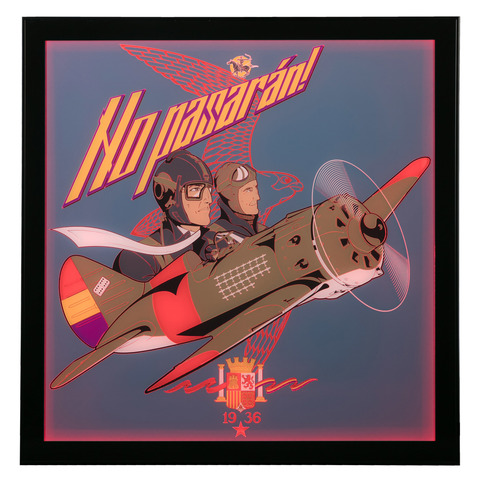Красные соколы
В 1931 на муниципальных выборах в Испании победили республиканцы, король был свергнут, прошли выборы в Учредительное собрание, где республиканцы получили 83%. Пятилетний период бурной политической жизни, стачек, восстаний и реформ привел в 1936 году к созданию и победе на выборах леволиберального «Народного Фронта». 17 июля правые силы совершают попытку военного переворота с которого начинается Гражданская война.

Фото 1. Плакат на улицах республиканского Мадрида
Хотя почти все ВВС сохранили верность республиканскому правительству, быстрое насыщение вооруженных сил правых фалангистов поставляемыми Германией и Италией современными самолетами придало им значительное преимущество. Видя столь открытое вмешательство, первоначально придерживающийся нейтралитета СССР решил не оставлять республиканцев наедине со столь сильными противниками. В октябре прибыла первая партия из 31-го истребителя И-16 и Р-5. В порту советские специалисты были поражены остановкой разгрузки секретных истребителей из-за ухода испанцев в середине дня на сиесту и с трудом смогли вернуть их к работе. Интересно, что собранные P-5 пилотировались членами эскадрильи «Ультиматум» - группой выходцев из Общества Друзей Воздушного Флота, которые за 15 лет до этого собирали деньги на развитие советской, авиации агитируя прохожих в Москве, а также поднимали и восстанавливали лежавшие на Ходынке старые Ньюпорты. Название эскадрильи было ответом на ультиматум лорда Керзона, который помимо всего прочего требовал от СССР отказаться от планов «экспорта революции» в Индию, Персию, Афганистан, то есть от реализации идей Петра Великого и возможного погибшего из-за них императора Павла I. А ведь уже в 1919 году делегация из Индии, прибыла в Ленинград с просьбой о помощи в свержении английского колониализма. Таким образом, советские соколы изначально тонко чувствовали геополитическую повестку и, как самый мобильный род войск, готовились биться с врагом в любой точке Земного шара.

Фото 2. Советский плакат ранних 1920-х годов
Как уже было отмечено в других статьях, любой конфликт это не только битва характеров, школ, доктрин и народов, но еще и состязание конструкторов, инженеров и целых отраслей промышленности. Сразу после прибытия, И-16 тип 5 стал серьезной угрозой для немецких бипланов Heinkel He-51 и итальянских Fiat CR-32. Даже более ранний И-15 уже достойно с ними конкурировал. И-16 превосходил вражеские истребители по скорости на 60-80 км/ч, по скороподъёмности — приблизительно на 200 м/с. Кроме того, И-16 стал первым истребителем, способным вести бои на вертикали. Пилотам националистов рекомендовалось не вступать в бои с И-16, не имея численного преимущества, но даже в последнем случае победа далеко не всегда оставалась за мятежниками.

В тоже время проявились недостатки конструкции — слабость пулеметов винтовочного калибра, ненадежный двигатель, забрызгивание фонаря маслом, слабая бронеспинка, недостаточная прочность крыльев, узкие колеса шасси. В 1937 году в небе появился только что созданный Messershmitt Bf.109. Первыми на помощь Франко были направлены прототипы Bf.109V и серийные Bf.109B. Превосходя И-16 в скорости (на 10-20 км/ч, в зависимости от высоты), имея вооружение такое же, как на И-16 тип 6, немецкий самолет уступал истребителю Поликарпова в скороподъёмности и маневренности. Время виража у И-16, за счет малых размеров и задней центровки, составляло12,3 секунды против 18 секунд у Bf109. Из-за расположенных в основаниях крыльев радиаторов системы охлаждения, двигатель Bf.109 можно было вывести из строя одним прямым попаданием. Эта проблема была устранена только на более поздних Bf109 F и K версий, когда появилась возможность перекрывать поврежденный радиатор. В случае перекрытия обоих радиаторов, двигатель мог работать еще около 5 мин. Установленный на И-16 двигатель М-25 (лицензионная копия американского Wright R-1820 Cyclone), мог работать даже с несколькими пробитыми цилиндрами и обеспечивал высокую защиту летчику спереди, поэтому И-16 предпочитали атаковать «в лоб», пикируя с высоты. Отвечая на появление Bf109, с марта 1938 года СССР начал поставки в Испанию И-16 тип 10, который отличался усиленным вооружением (4 ШКАСа) и форсированным двигателем М-25В. Тем не менее, со временем И-16 все сильнее проигрывал в высотности, испанцы частично решили проблему переоборудованием 12 самолетов на двигатель Hispano-Suiza с наддувом, установкой кислородных приборов, нагнетателей, предохраняющих оружейную смазку от замерзания на высотах до 8000м.
С новым Bf109E c 20мм пушкой и мощным 1085 сильным двигателем И-16 конкурировать уже не мог. Морская блокада и сухопутные успехи националистов привели к сворачиванию советской военной миссии. Часть испанских пилотов, в том числе Мануэль Сарауса Клавьер с 23 воздушными победами, после падения республики через Францию перебрались в СССР и продолжили службу. Наиболее результативным летчиком этой войны был летавший на Fiat CR.32 националист Хоакин Гарсиа-Морато с 40 победами, второе место за героем СССР Львом Шестаковым с 39 победами и Грицевец Сергеем с 30, оба летали на И-16, которых за всю компанию было поставлено 422 самолета. Компания в Испании дала толчок для дальнейшего развития авиации в СССР - Сталин, до этого веривший в непобедимость изделий Поликарпова (что соответствовало реальности в 1935-1936гг.) направил больше ресурсов в конструкторские бюро Микояна и Гуревича, Лавочкина и Яковлева. К.Е.Ворошиловым был утвержден «План использования в боевой подготовке ВВС РККА выводов из боевой работы авиации в Испании», в боях были добыты и переправлены в СССР новейшие Bf.109 и He.112
Мода носить белые шелковые шарфы из парашютной ткани появилась в открытых кабинах бипланов и трипланов Первой Мировой войны, став своего рода визитной карточкой «небесных рыцарей». Шелк позволял не натирать шею во время осмотра небосвода и сохранял тепло. В СССР шарф предпочитали носить первый дважды герой Советского Союза Б. Ф. Сафонов и члены его эскадрильи.
Источники:
Википедия
http://i16fighter.ru/operational-history/spain.htm
 En
En Ru
Ru


